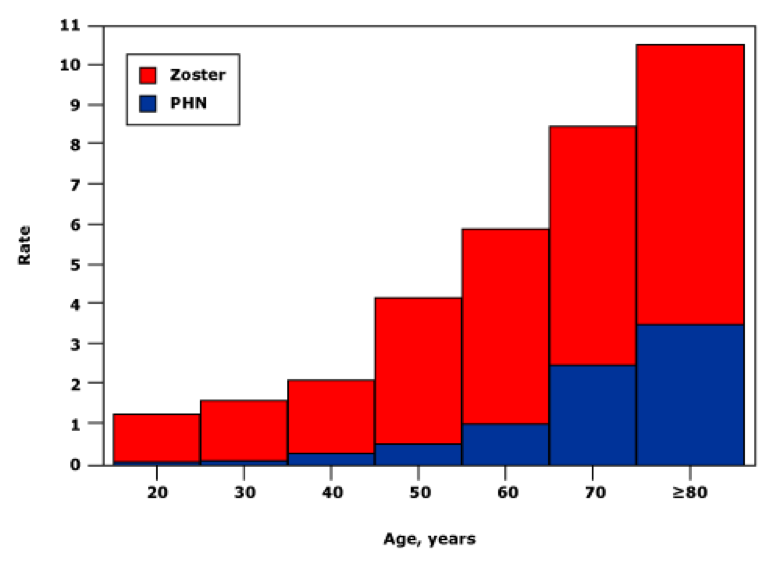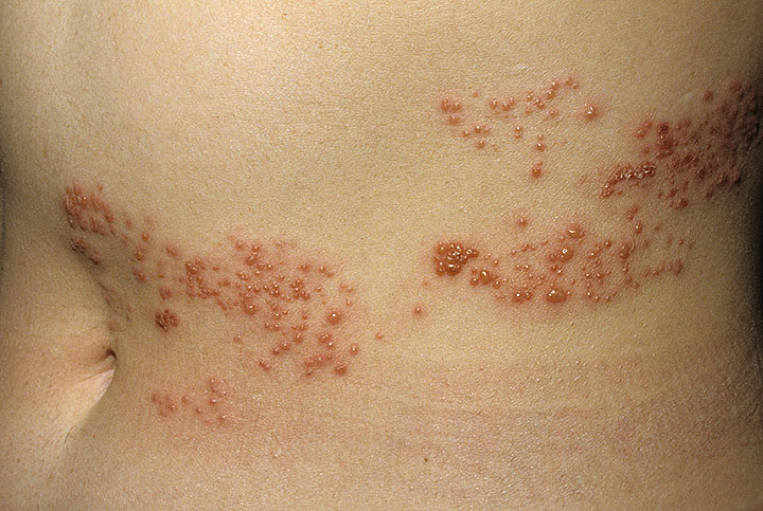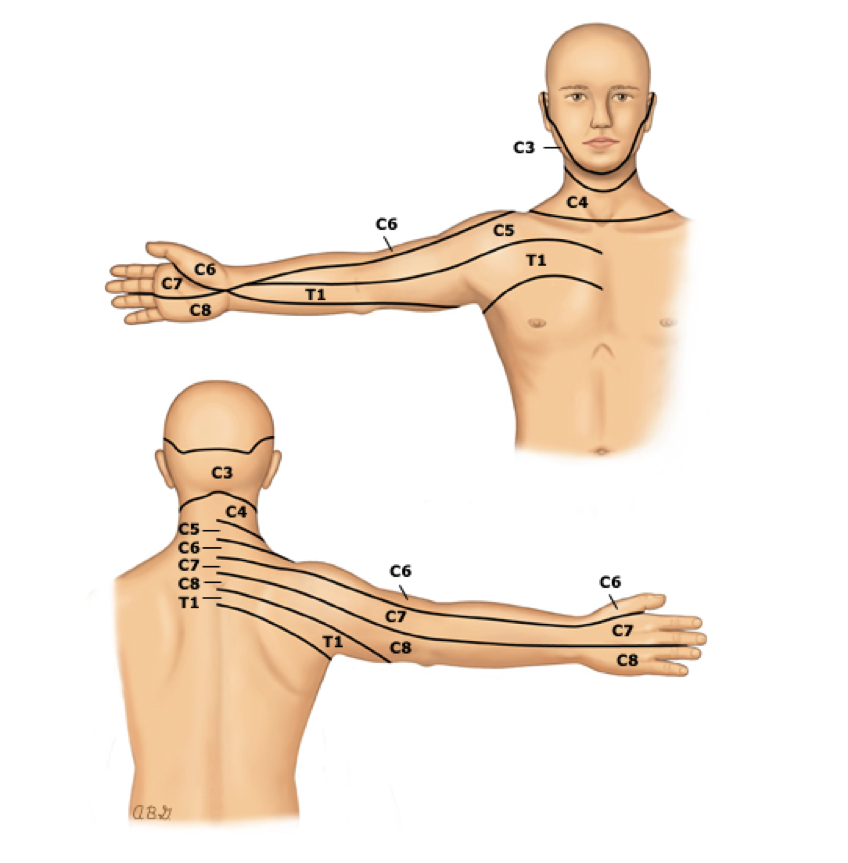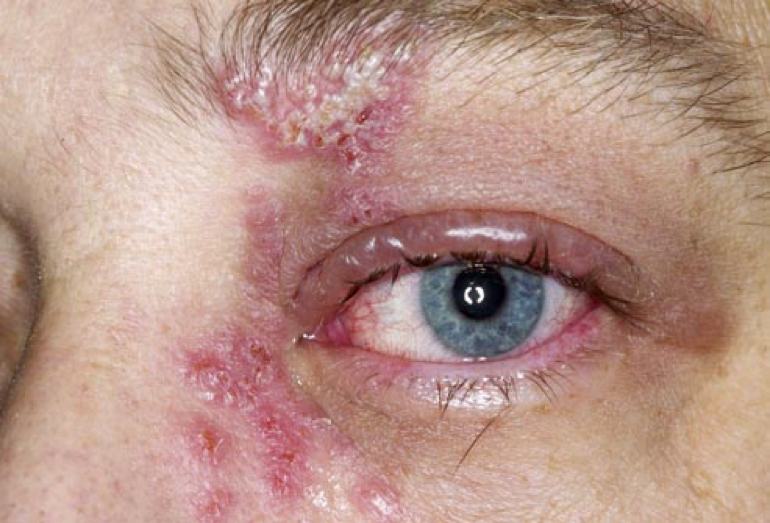In the United States, herpes zoster (shingles) occurs in nearly one million individuals annually. Shingles will affect 32 percent of persons in the United States during their lifetime. The incidence of shingles increases with age, presumably due to the decline in cell-mediated immunity for the virus that causes shingles. A dramatic increase in disease rates begins to occur after 50 years of age. It is estimated that approximately 50 percent of persons who live to age 85 will have an episode of shingles. Older patients with shingles account for the majority of medical consultations and hospitalizations for this diagnosis.
Rates of zoster and postherpetic neuralgia (PHN), by age - United States

Cause
Shingles are caused by the varicella-zoster virus (VZV). It is a reactivation of the virus that causes chickenpox. Varicella-zoster virus (VZV) infection causes two clinically distinct forms of the disease: varicella (chickenpox) and herpes zoster (shingles). Primary VZV infection results in the diffuse blister-like rash of chickenpox. Clinical resolution is followed by the establishment of a dormant infection within the sensory dorsal root ganglia. Reactivation of this virus leads to herpes zoster, or shingles, a painful, unilateral vesicular eruption in a restricted pattern following skin lines.
Transmission
The varicella-zoster virus is transmitted from person to person by direct contact or by spreading the virus from skin lesions in the air. Persons are not infectious before skin lesions appear and are no longer infectious when the lesions have started healing. Individuals who have not had chickenpox, and are exposed to a patient with shingles, are at risk for developing chickenpox. During the initial phase of chickenpox, the virus is introduced to tissue in the nose and oral cavity via airborne viral droplets. This is followed by rapid spread to regional lymphoid tissue.
The risk of infection in a susceptible person varies by the duration and nature of the exposure. Increased risk should be considered with indoor face-to-face contact with a person with chickenpox or close contact with a person with shingles. Chickenpox is very contagious. Some experts consider exposures of more than five minutes of concern, while others contend that only those with more than one hour of contact are significant. However, there is general agreement that those with the greatest risk of exposure are household contacts where transmission rates are >90 percent.
Transmission of the virus that causes chickenpox and the shingles from a patient with shingles is uncommon but may occur within households with sustained exposure to open lesions. Persons with shingles should be instructed to keep lesions covered, whenever possible, to decrease the risk of environmental contamination with the virus. Using occlusive dressings is better at preventing contamination with the virus than a standard gauze bandage.
Signs & Symptoms
The presenting clinical signs of shingles include a blister-like rash and acute nerve inflammation, which can precede, or occur simultaneously, with the rash; the nerve pain may persist for weeks after the rash has crusted over. The rash of shingles starts as red papules, which quickly evolve into grouped blisters. Within three to four days, these blister-like lesions can become more pustular or occasionally hemorrhagic. The lesions will usually crust by 7 to 10 days and are no longer considered infectious. Shingles are generally limited to one dermatome in healthy individuals, but can occasionally affect two or three neighboring dermatomes. A dermatome is an area of skin innervated by sensory fibers from a single spinal nerve.

Rash of shingles involving the abdomen

Cervical dermatomes
The thoracic and lumbar dermatomes are the most commonly involved sites of the shingles. Fewer than 20 percent of patients have significant systemic symptoms, such as headache, fever, malaise, or fatigue.
Pain is the most common symptom of shingles. Approximately 75 percent of patients have pain in the dermatome where the rash subsequently appears. Pain may be constant or intermittent and can precede the rash by days to weeks. Most patients describe a deep burning, throbbing, or stabbing sensation. Some individuals describe the pain only when the involved area is touched, whereas others complain primarily of itching.
The most common complication of herpes zoster is postherpetic neuralgia (PHN). PHN refers to pain persisting beyond four months from the initial onset of the rash. Sensory symptoms can include pain, numbness, dysesthesias, and allodynia (pain precipitated by movement) in the affected dermatome. PHN occurs in approximately 10 to 15 percent of all patients with shingles. The risk of developing PHN is significantly higher in older adults (greater than 50 years of age). Other complications include bacterial skin infection from lesions, eye complications such as uveitis and keratitis, motor neuropathy, meningitis, and herpes zoster opthalmicus.

Shingles affecting the eye. Concern for herpes zoster ophthalmicus, a serious sight-threatening condition, linked to the virus reactivation within the trigeminal ganglion. Patients can develop conjunctivitis, episcleritis, keratitis, and/or iritis. Early diagnosis and treatment are critical to prevent progressive corneal involvement and potential loss of vision.
Treatment
Treatment of shingles is with an anti-viral medication such as Acyclovir, Famciclovir, or Valcyclovir for one week. Antiviral therapy should be initiated within 72 hours of clinical presentation in patients greater than 50 years of age to maximize the potential benefits of treatment. Important goals of antiviral therapy are to lessen the severity and duration of pain associated with acute neuritis, promote rapid healing of skin lesions, prevent new lesion formation, decrease viral shedding to reduce the risk of transmission, and prevent post-herpetic neuralgia.
Although antiviral therapy reduces pain associated with acute neuritis, pain syndromes associated with shingles can still be severe. Nonsteroidal anti-inflammatory drugs (Ibuprofen or Naprosyn) and Acetaminophen (Tylenol) are useful for mild pain. However, a weak opioid analgesic such as codeine or tramadol may be needed with these medications. For moderate to severe pain, stronger opioid analgesics such as morphine or oxycodone may be necessary.
Prevention
A vaccine has been developed to help prevent shingles and is currently given once in a lifetime. The zoster vaccination for the prevention of shingles is recommended in people aged 50 years and older, including patients who have a prior history of herpes zoster (shingles). The zoster vaccine should not be administered to individuals with a history of an anaphylactic reaction to gelatin or neomycin. Additionally, the vaccine should be avoided in populations that are at high risk for developing widespread varicella-zoster virus infection since it is a live vaccine. These individuals include patients with primary or acquired immunodeficiencies (including leukemia, lymphoma, or other malignancies affecting the bone marrow or lymphatic system, undergoing chemotherapy or radiation treatment, history of solid organ transplantation, taking daily corticosteroids with a dose greater than 20mg daily, receiving rituximab or a tumor necrosis factor, have HIV and CD4 cell count less than 200.
Patient Plus Urgent Care – Get in, Get better.
When you’re sick or injured, whether routine or urgent, quality medical care should be easy to find and available when you need it. That’s the idea behind Patient Plus Urgent Care, with convenient locations in Baton Rouge, Hammond, Prairieville, & Brusly.
Patient Plus treats most common illnesses and injuries — the sniffles, rashes, fevers, aches, breaks, and other conditions that deserve prompt treatment but aren’t serious enough to require a trip to the nearest emergency room. The clinics provide complete diagnostic services, including X-rays, EKGs, and flu and strep tests. Other services include physicals, vaccinations, and more. Patient Plus clinics are open every day from 9 a.m. to 9 p.m., and patients never need to call first or make an appointment.

